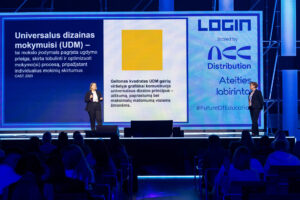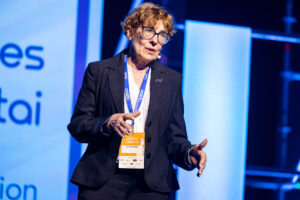Do you remember a lesson that still sticks in your mind because you didn’t understand something? And the stress when the teacher tells you there’s a test coming up and you want to pass it? “Every child wants to succeed at school. Success encodes perspective, forward movement, it’s like a reward. Unfortunately, at the moment, some pupils are rather apathetic in lessons, they are just wasting their time,” says Vitalija Bujanauskienė, the Director of the Utena Education Centre.
Together with Indre Širvinskaite, an expert on inclusive education from the Education Progress Programme “Millennium Schools” (MSP), she presented a paper entitled “MSP, UDM, STEAM in education: why decode?” at the recent LOGIN conference.
According to the speakers, active learning, where there is genuine interest, requires the integration of several subjects, but this is often lacking in the classroom. It is very likely that the innovations and technologies coming into education will enable the next generation to succeed. One of the conditions for this is the merging of different fields and methods into one.
The MSP programme promotes school improvement in four areas: leadership by action, cultural education, STEAM education and inclusive education. It was the links between the latter two areas and how they can work together – as an educational innovation – that were the focus of the presentation.
Universal Design for Learning (UDM) comes to education through the field of inclusive education, one of its approaches based on neuroscience and educational science. Its guiding principles are clarity and simplicity for all. This approach, which recognises the individual differences of pupils, is designed to enable every child in mainstream education to succeed.
“Whether a pupil is under-motivated, has a disability, comes from a disadvantaged socio-economic background, or is very gifted and bored of sitting in a classroom, the UDM allows us to plan the educational process in a way that meets the needs of each individual,” says I. Širvinskaitė.
According to neuroscience, three questions become important: why, what and how do I learn? For an effective learning process, it is recommended to plan a variety of tools and techniques, because everyone’s brain is different: we engage differently, we remember information, we act differently, we are motivated by different things.
“Imagine a swimming lesson. Not everyone learns to swim in their lifetime: maybe they just don’t want to, maybe they have fears. The UDM talks about the fact that in an educational environment and process, there may be various barriers that will hinder learning – we need to notice them, identify them and provide the necessary support to overcome them, the so-called scaffolding. In this case, it can be inflatable sleeves, buoys, so that everyone can get involved in the swimming lesson”, says the IMF Inclusive Education Expert.
Meanwhile, the second term discussed, STEAM, is an acronym for the first letters of English words: Science, Technology, Engineering, Arts, Arts and Creativity, Math, Mathematics.
“If we learn science, maths, arts separately, STEAM does not happen. It happens when there is a need for hands-on action: when the student explores, is curious, and comes up with his own solutions. This is deep learning, where we not only have the ‘forged’ components, but also the development of competences through action,” explains V. Bujanauskienė.
According to the speaker, STEAM is not only a concern for Lithuania, it is a concern for the whole world. The development of technology has gained such momentum that just learning individual subjects is not enough to solve all the problems, innovation and quality of life. It is worth mentioning that everyone is exposed to STEAM in real life, in different situations, using their own competences: for example, programming special garden watering cans, exercising while taking food supplements, cooking more sophisticated dishes, etc.
According to Ms Širvinskaitė, the MSP programme provided an opportunity to experience how UDM and STEAM fit together. These approaches are quite new in Lithuania and in our national education system. However, upon closer inspection, it is clear that combining these concepts can bring even greater innovation.
As we started to analyse UDM access in Utena at the beginning of 2019, and as we will open one of the open access STEAM centres in 2022, we have already merged these two ideas. Through the UDM programme, we are further exploring how the neuroscience-based UDM approach and STEAM, for which active learning is a key process, work together. We see that they both go in the same direction – towards deep learning for every child who is different”, says the Director of the Utena Education Centre.
Problem solving, critical thinking, collaboration, willingness to engage – these are the key components of this harmony between the two areas. When put into practice, it makes learning fun, engaging, not only knowledge-based, but also 21st-century competence-building.
“So far, we have only touched the surface of these interactions, the future of which will depend on how teachers, educators and society apply these approaches. Together, they really bring great innovation and great potential. If children are taught according to these approaches, they will leave school independent, able to distinguish and accept their own and others’ differences, able to create, work together and face the challenges of the future. And this will help each and every one of them to achieve educational success and, very likely, success in life”, concludes I. Širvinskaitė.
Original source: Inovacijos švietime: ko reikia, kad kiekvienas mokinys pasiektų sėkmę? – Tūkstantmečio mokyklų programa




